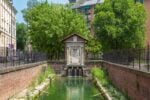Nikita Kadan – Everybody wants to live by the sea
.jpg)
Viafarini DOCVA presenta la ricerca di Nikita Kadan (Kiev, 1982). La mostra è a cura di Silvia Franceschini con il supporto di Victor Pinchuk Foundation all’interno della cornice della residenza VIR Viafarini-in-residence.
Comunicato stampa
Viafarini DOCVA presenta la ricerca di Nikita Kadan (Kiev, 1982). La mostra è a cura di Silvia Franceschini con il supporto di Victor Pinchuk Foundation all’interno della cornice della residenza VIR Viafarini-in-residence. L’inaugurazione sarà preceduta da una conversazione con l'artista che illustrerà il suo lavoro sullo sfondo della prima versione installativa della ricerca in progress Everybody wants to live by the sea.
Nella sua ricerca sul territorio della Crimea, balzata all'attenzione internazionale a causa dei recenti eventi di violenza, Nikita Kadan scava nel passato di questa terra da sempre soggetto di controversie. Memorie nascoste di popoli, nazioni e stati in lotta per il possesso della penisola si fondono insieme ai ricordi personali dell'artista in un display semi-documentario di immagini e forme architettoniche che racconta la storia presente del territorio, il suo passato e, di conseguenza, il suo futuro.
Storicamente la Crimea è stata sede di diversi gruppi etnici e religiosi. Uno di loro, i Tatari di Crimea, fu deportato nel 1944 dalla penisola per ordine di Stalin come forma di punizione collettiva per la sua presunta collaborazione con il regime di occupazione nazista. La deportazione è rimasta il retroterra vergognoso di una delle più famose località turistiche sovietiche, un paradiso situato tra il Mar Nero e Mar d'Azov. Dopo la caduta dell'Unione Sovietica, i Tatari di Crimea sono tornati nella loro patria e hanno iniziato a ri-occupare il territorio con insediamenti auto-costruiti. Questi fragili rifugi architettonici sono spesso lasciati incompiuti o sono distrutti dalle autorità locali guidati da una nuova ondata di xenofobia nei confronti dei Tatari che sono ancora oggetto di esclusione nella nuova "Crimea Russa". Kadan interpone disegni delle forme geometriche di architettura modernista, che richiamano alla mente il paradiso sovietico della Crimea, costruito sul territorio dei Tatari dopo la sua pulizia etnica, tra le fotografie documentarie degli insediamenti. L'insediamento diventa uno scheletro su cui una nuova società sta attualmente emergendo, guidata da un nuovo idealismo nazionale che assomiglia sospettosamente a quello sovietico.
Un profilo sottile in neon definisce la Crimea come isola autonoma che in realtà sta diventando un oggetto di manipolazione da parte di diversi interessi geopolitici. Il romanzo di fantascienza "L'isola di Crimea”, scritto da Vassily Aksyonovnel nel 1979, immaginava una storia alternativa in cui la guerra civile russa si è conclusa con le forze zariste in grado di mantenere questo residuato meridionale del vecchio impero. Il romanzo termina con la Russia, annettendo Crimea dopo che i suoi cittadini stessi ne hanno richiesto l’invasione, quasi a predire l'attuale occupazione russa della Crimea.
L'utopia socialista della Crimea viene ricostruita da un display documentario con una raccolta di immagini che spaziano dal 1960 al 1980 e opuscoli che rappresentano l'infrastruttura modernista per il tempo libero e per il benessere - sanatori, alberghi, ristoranti, spiagge e piscine - così come la vita felice dei turisti provenienti dalle repubbliche sovietiche. Le fotografie sono state realizzate da Tass (acronimo di Telegraph Agency dell'Unione Sovietica) e utilizzate per pubblicizzare la Crimea come una delle migliori destinazioni turistiche dell'Unione Sovietica.
Nikita Kadan (Kiev, 1982) vive e lavora a Kiev. Diplomatosi presso la National Academy of Fine Art a Kiev dove ha studiato Monumental Painting. Dal 2004, è membro del gruppo R.E.P. (Revolutionary Experimental Space) e co-fondatore e membro del gruppo di attivismo e curatela HudRada. Nikita Kadan ha esposto presso Palazzo Reale a Milan, presso Deutsches Historisches Museum a Berlino, presso Zamek Ujazdowski Art Centre a Varsavia e presso il Museo d'Arte Nazionale di Kiev. La sua opera "Procedure Room" è stata acquisita nella collezione del Pinakothek der Moderne a Monaco di Baviera. Nel 2011 è stato insignito del Pinchuk ArtPrize e nel 2012 e 2014 è stato finalista del Future Generation ArtPrize.
*****
Nikita Kadan
Everybody wants to live by the sea
curated by Silvia Franceschini
artist talk and opening: Wednesday 25th June, 6.30 pm
exhibition: 25 June - 18 July 2014
venue: Viafarini DOCVA, Fabbrica del Vapore, via Procaccini 4, Milan
Viafarini DOCVA presents the research of the Ukrainian artist Nikita Kadan (Kiev, 1982). The exhibition, curated by Silvia Franceschini, focuses on
a conversation with the artist, who will present his works against the background of the first version of the installation from his ongoing project Everybody wants to live by the sea.
In his research on the territory of Crimea, which became internationally known because of recent violent events, Nikita Kadan goes deep into the past to when this land was the subject of dispute. Hidden memories of the peoples, nations and states struggling for the possession of the peninsula as well as the artist's personal memories are transformed in a semi-documentary display of imagery and distinctive architectural forms that tells the story of the land, its past and, consequently, its future.
Historically Crimea was home to different ethnic and religious groups. One of them, the Crimean Tatars, was deported in 1944 from the peninsula by Stalin's orders as a form of collective punishment for alleged collaboration with the Nazi occupation regime. The deportation remained the shameful underside of one of the most famous Soviet resorts, a paradise situated between the Black and Azov Seas. After the fall of the Soviet Union, Crimean Tatars returned to their ancestral homeland and started to re-occupy the territory with self-built settlements. These fragile architectural shelters are often left unfinished or are ruined by local authorities driven by a new wave of xenophobia towards Crimean Tatars who are again becoming an object of exclusion in the new “Russian Crimea”. Kadan interposes drawings of the geometrical shapes of modernist architecture, which call to mind the Soviet paradise of Crimea built on the Crimean Tatars' territory after its ethnic cleaning, between documentary photographs of the Tatar settlements. The settlement becomes a skeleton upon which a new society is currently emerging, driven by a new national idealism which suspiciously resembles the Soviet one.
A thin neon profile defines Crimea as an autonomous island which in reality is becoming an object of manipulation by different geopolitical interests. Written in 1979, the fiction novel “The Island of Crimea” by Vassily Aksyonov imagined an alternative history wherein the Russian civil war ended with the tsarist forces able to hold on to this southern scrap of the old empire. The novel ends with Russia annexing Crimea after its citizens are tricked into requesting the invasion themselves, almost predicting the current Russian occupation of Crimea.
The utopia of Socialist Crimea is reconstructed by a documentary display with a collection of images from the 1960s to 1980s and booklets representing the modernist infrastructure for leisure and healthcare – sanatoriums, hotels, restaurants, beaches and swimming pools – as well as the happy life of tourists coming from different Soviet republics. The photographs were done by Tass (Telegraph Agency of the Soviet Union) and used to advertise Crimea as one of the best tourist destinations of the Soviet Union in Italy and in the rest of the world.
The exhibition is supported by the Victor Pinchuk Foundation in Kiev. The photographic materials on display are courtesy of the archive of Associazione Italia Russia in Milan.
Nikita Kadan (Kiev, 1982). lives and works in Kiev. He graduated from the National Academy of Fine Art in Kiev where he studied Monumental Painting. Since 2004, he has been a member of the R.E.P. (Revolutionary Experimental Space) group and co-founder and member of HudRada curatorial and activist group. Nikita Kadan has exhibited at Palazzo Reale in Milan, at the Deutsches Historisches Museum in Berlin, at the Zamek Ujazdowski Art Centre in Warsaw and at the National Art Museum in Kiev. His work Procedure Room is in the collection of the Pinakothek der Moderne in Munich. In 2011 he received the Pinchuk Art Prize and in 2012 and 2014 he was shortlisted for the Future Generation Art Prize.



